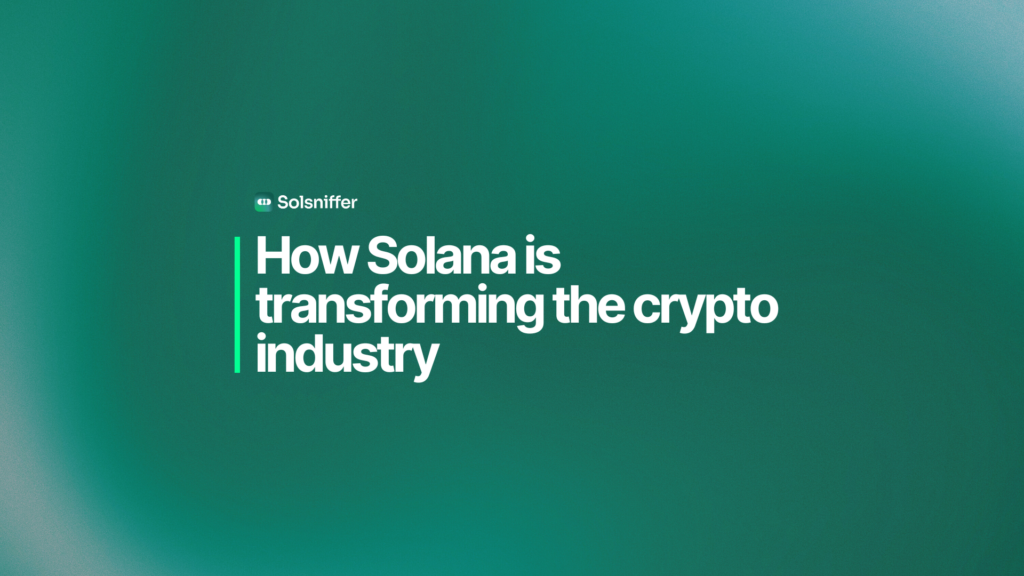As blockchain technology continues to develop, new platforms emerge, each promising improvements over their predecessors. Among these, Solana stands out as a transformational blockchain platform offering unparalleled speed and scalability. Launched by Anatoly Yakovenko and released in March 2020, Solana has quickly gained traction in the crypto industry, becoming known for its innovation and efficiency. Many important projects, like Solsniffer, are now building on the blockchain, utilizing tools like a token scanner to ensure safety and prevent trading crypto scams.
Solana began with a whitepaper released in 2017, introducing Proof of History (PoH). Over three years, it evolved into a robust blockchain solution without compromising security or decentralization. At the heart of Solana’s functionality lies PoH, an algorithm designed to cryptographically verify the passage of time between events. This innovation enhances trust and efficiency within the consensus mechanism, setting Solana apart from other blockchain networks.
How Solana Works
Solana addresses the blockchain trilemma of scaling, security, and decentralization through several key innovations:
- Tower BFT: Solana utilizes a modified Byzantine Fault Tolerance technique, known as Tower BFT, which employs PoH as a cryptographic clock. This method enables rapid consensus without extensive communication among nodes, significantly enhancing the network’s efficiency.
- Turbine: Turbine is an innovative block propagation technology that breaks data into smaller packets for transmission. This reduces bandwidth usage and accelerates network performance, contributing to Solana’s exceptional speed.
- Gulf Stream: For faster transaction processing and increased network capacity, Gulf Stream pushes transaction caching and forwarding to the edge. Validators can execute transactions before their scheduled timestamp, reducing confirmation times and boosting network throughput.
- SeaLevel: Solana’s parallel smart contract runtime feature, SeaLevel, allows simultaneous execution of smart contracts, increasing throughput and efficiency. This capability is crucial for managing complex decentralized applications (dApps).
- Pipelining: Solana employs an optimized transaction processing unit that distributes input data streams across various hardware components. This setup ensures rapid validation and replication of transaction information, further enhancing network performance.
Solana’s standout feature is its impressive speed and throughput. The network can handle 65,000 transactions per second (TPS) with 400-millisecond block times, far surpassing the capabilities of networks like Bitcoin and Ethereum, which manage between 7 TPS and 15-45 TPS, respectively. This makes Solana an attractive crypto trading platform for high-frequency traders.
Solana’s Native Token: SOL
Solana’s native cryptocurrency, SOL, is used to pay for transactions and smart contract executions. Validators stake SOL tokens to secure the network and achieve consensus. The rising value of SOL reflects growing interest and confidence in the platform, making it a contender for the best crypto coin to buy.
Solana Ecosystem and DApps
Solana’s ecosystem has experienced phenomenal growth, hosting a variety of projects and applications, including decentralized finance (DeFi) systems, non-fungible token (NFT) marketplaces, and gaming applications. This vibrant ecosystem underscores Solana’s versatility and appeal to developers and users alike.
The platform supports advanced crypto portfolio management tools like Solsniffer, allowing users to track and optimize their investments across different dApps. Crypto trading bots are increasingly integrating with Solana’s blockchain, automating cryptocurrency trading and providing crypto trading signals that help traders make informed decisions.
Despite its impressive capabilities, Solana has faced challenges such as network congestion and outages. Critics also point to the high hardware requirements for validator nodes, raising concerns about the level of decentralization. With everyone in search of the next big meme coin, scammers are also increasing on the platform. One of the best cryptocurrency intelligence tools on Solana is Solsniffer, which is fighting tooth and nail against scammers and empowering investors with the right information before engaging with any contract, ensuring crypto security.
Solana’s Future Prospects
As the demand for fast, scalable blockchain solutions grows, Solana is well-positioned to meet these challenges. The platform continues to attract high-profile partnerships and collaborations, solidifying its place in the crypto space. Notable partnerships, such as the one with Serum, a decentralized exchange (DEX) built on Solana, highlight the platform’s potential to offer fast and low-cost trading.
Additionally, Solana’s blockchain data security features and Solsniffer crypto data APIs facilitate secure transactions from on-chain data transactions and analysis, enhancing user trust. These features are crucial as more users seek reliable platforms to engage in crypto trading and investment activities.
Solana is well-positioned to redefine the future of finance and decentralized applications, paving the way for widespread adoption and utility. Its ability to handle large volumes of transactions efficiently positions it as a leading blockchain platform, especially in the automated cryptocurrency trading sector.
Solsniffer, Secure Trading and Security on Solana
Solana token scanner: https://solsniffer.com/sniftokens/
Solana wallet portfolio tracker: https://solsniffer.com/snifwallets/
X (Twitter): https://x.com/solanasniffer
Telegram: https://t.me/solana_sniffer

